If you want to add fascinating creatures to your reef tank, starfish may appear as a desirable option. While they indeed raise the aesthetic appeal of any aquarium, not all of them will do that for you because most starfishes are not aquarium-friendly or reef-safe!
Then which ones are the best reef-safe starfish? I could name a bunch. For example, Brittle Starfish, Indian Sea Starfish, Orange Sea Starfish, Red Fromia Starfish, and Red Serpent Starfish are the easiest and safest choices for keeping in captivity.
The thing with these Starfishes is that they have somewhat a good chance of surviving in a captive environment. Most just starve for a while and then start eating the reef itself. So it is paramount to understand what you bring into your reef system beforehand.
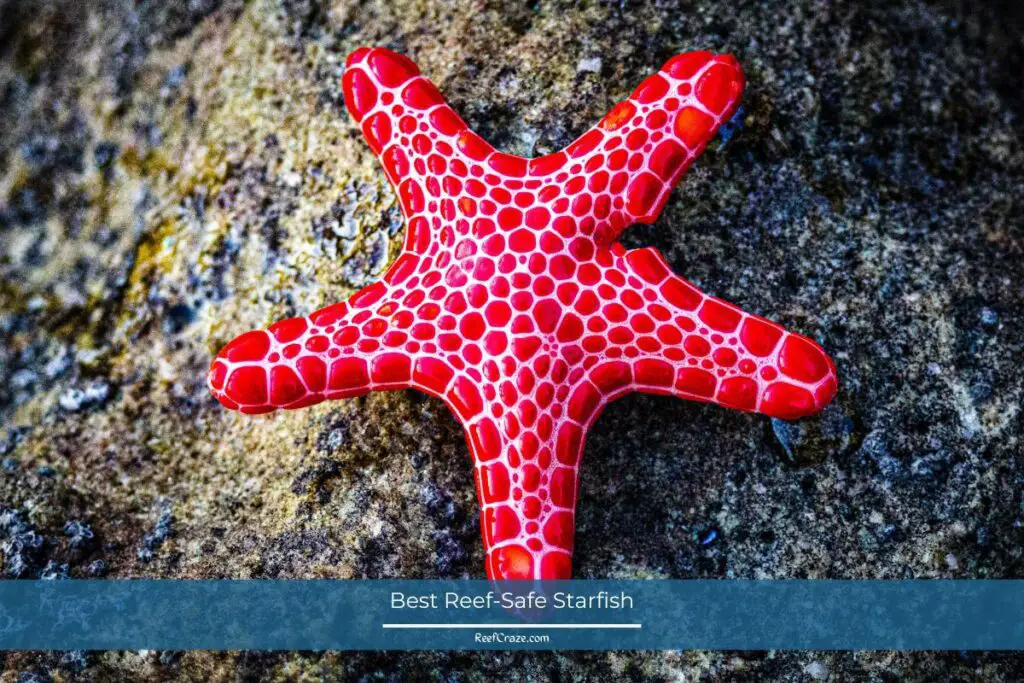
4 Best Reef-Safe Starfish For Your Reef Tank
Every Starfish needs a mature tank because of their low tolerance to an unstable environment with volatile pH, water temperature, and salinity. Besides, copper-based substances used to treat sick fish will respond horribly in the presence of Starfishes and cause fatalities.
Starfish that you can consider reef-safe are typically hostile toward small clams, shrimp, and anemones that host algae and fish. So you see, reef-safe does not clear all your tank residents out of danger.
There are many Starfish species. So researching the one you plan to keep in your tank is essential to ensure you can afford their maintenance because they do not thrive in home tanks and require additional feeding.
However, when you make up your mind to own a Starfish, you must look for the ones your tank can actually accommodate. Speaking of that, discover them below!
1. Brittle Starfish (Ohiuroidea)
Okay, so Brittle Starfish is not really a true sea Starfish. But it has five arms around a central physical structure, almost like a sea Star. So cut me some slack here. Belonging to the family of Ophiuroidea, their key features are their spindly and long arms.
They are the most common Starfish to keep in an aquarium, being the first choice for hobbyists. Despite a misleading name, they are pretty hardy, unlike other Stars, and will adapt just fine in a fish-only tank. They are also safe if you have corals in your tank.
Brittles are excellent at disposing of excess fish food and detritus in the water. You will find yours scavenging at night, but you can still try target-feeding tiny chunks of fish upon locating them.
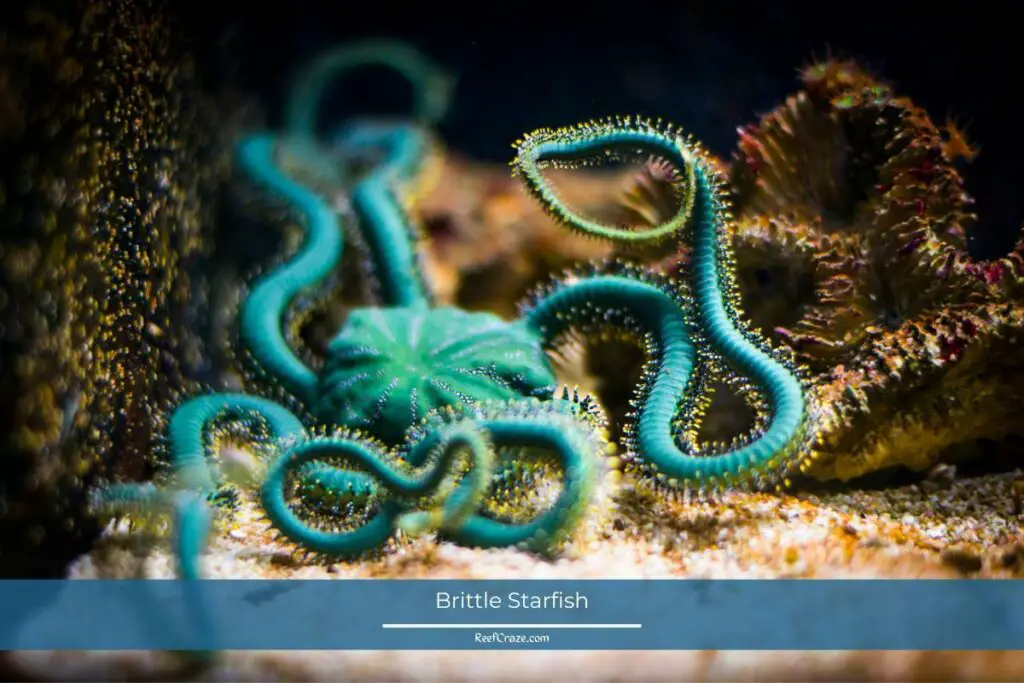
Remember one or two things before shopping for a Brittle Starfish. First, some Brittle styles are not reef-safe, i.e., the Green Brittle Starfish. You must research them thoroughly to decide on a specific type and confirm its safety.
Another thing is that some species become large when completely grown. If that does not suit your tank, you want to get mini Brittles that do not increase in size above 2 inches.
2. Red Fromia Starfish (Fromia Milleporella)
It is the second most familiar Starfish to spot in a reef aquarium. You will see it in any local store. You may also know it as the Black-Spotted or Marbled Fromia Starfish, its other two types.
Reefers who did not quite like the off-putting appearance of the Brittle Star will want to check out the Red Fromia. It has a charming reddish-orange look.
Now there is a catch coming your way. You must have a mature and large reef tank to house a Red Fromia to support its foods’ growth, comprising sponges, biofilm, and algae. Supplemental treats will not do you much good because they usually refuse them. Try nori, meats, and flakes if you want to give them something anyway.
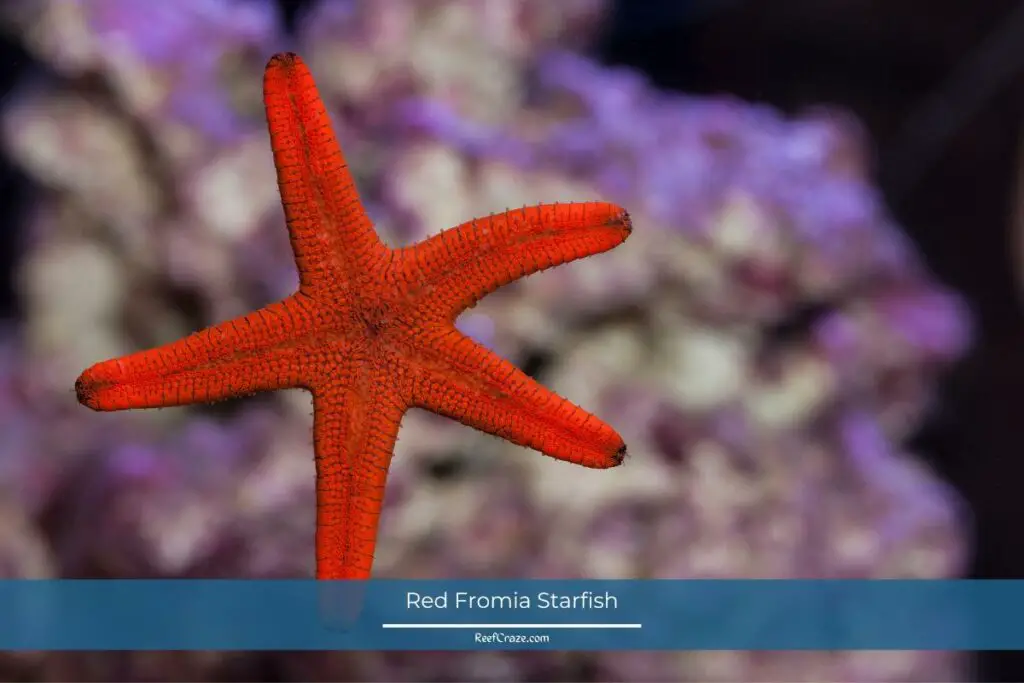
On the other hand, look at the bright side. Red Fromia is 100% reef-safe and not interested in feasting on your livestock.
It is naturally gentle and stays active during daytime and nighttime, making the best Starfish addition for your tank. And considering its sensitivity to water parameter changes, you should take enough time to acclimate it, particularly during water changes. Equally importantly, steer clear of applying any copper-based treatment.
Another version of the Fromia Star is the Indian Sea Star, with a slight change in its black-tipped pattern. Otherwise, everything is the same as the Red Fromia.
3. Orange Sea Star (Echinaster Sp.)
According to most aquarists, Orange Sea Stars adjust well to captive life and live long enough afterward. Sometimes called the Common Starfish, it is arguably their favorite Star due to its bright orange bumps that will color up any tank and catch anyone’s attention.
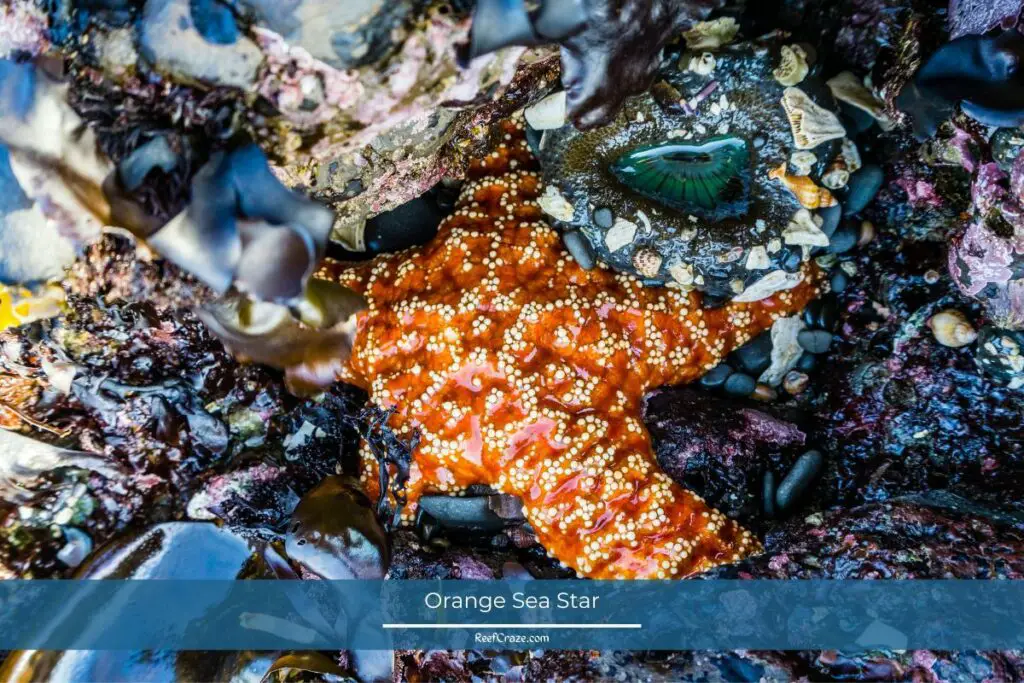
Any tank with a 50+ gallon capacity with a stable environment is enough to keep them. Besides, it must feature a good deal of live rock to allow for sufficient biofilm growth since the Starfish will live on biofilm, sponges, and algae.
You can provide additional fish foods, but getting them habituated to that with other tankmates waiting to fetch away the food will be challenging.
4. Red Serpent Starfish (Ophioderma Squamosissimus)
Serpent Starfish species resemble Brittle Starfish, both belonging to the Ohiuroidea group. Although sometimes people consider them synonymous, they differ in the reef-keeping hobby. The Serpent is an Ohiuroidea with smooth and glossy legs, and the Brittle has little spikes and protrusions on its appendages.
There are multiple species of this Star, but the one specifically suitable for an aquarium in every respect is the Red Serpent. They get as large as 12 inches or a foot in diameter. So a massive saltwater tank is a must. Nonetheless, their scary growth is of no concern for your dear livestock. They will do them no harm, especially the well-fed ones.
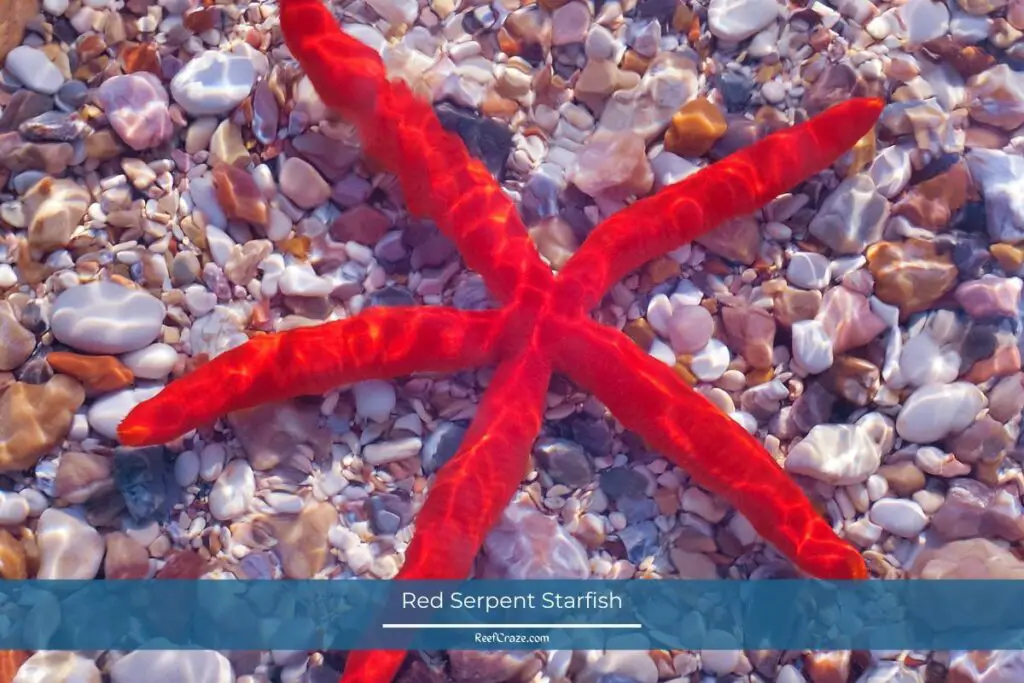
Another good news for hobbyists willing to feed their Starfish is that additional feeding is easily manageable with the Red Serpent, unlike the previous ones. Their carnivorous diet will gladly accept finely chopped shrimp, fish, mussels, and meat. Bear in mind that they are nocturnal feeders. Do not try to feed them during the day, and maintain a nightly feeding routine.
However, irrespective of the feeding schedule, they will adapt eventually and become active during the daytime and lie low at night. Their detritus-eating habit will also play a vital role in maintaining your tank environment quality.
Keeping the Red Serpent alive is simply because they are generally gentle and undoubtedly less aggressive than their Green cousins. Regardless, they will require your time and care to acclimate to the tank.
The next Serpent in line is the Banded Serpent Starfish. They are also nocturnal feeders and have a peaceful temperament. You can have them, too, instead of the Red Serpent.
Why You Should Avoid Asterina Starfish?
It is common for reefers to land up having an aquarium with a burgeoning population of Starfish without planning for it. The Asterina Starfish, a hitchhiker, and notoriously hungry species is often responsible for that.
They are also great at keeping your tank clean by eating waste and debris, but I kept them out of the list because of their rapid reproduction capability. They grow so fast that you will see them as an inconvenience instead of an addition to your aquarium.
This less-than-an-inch Star can also be problematic for another reason. They will eat anything and everything when they are hungry. If need be, they will even eat one another. They will not hesitate to devour your beautiful corals when they are short on their food supply.
It is not worth having them as they will endanger every other creature in your aquarium because of their predatory habits and expeditious population. In fact, when they start dominating in the tank, some reefers get Harlequin shrimp to thwart that.
Starfish That Are Not Reef-Safe
As I said, not every Starfish will be a boon for your reef tank. In fact, there are some you are better off avoiding. They are a complete no-no unless you are well aware of what you are dealing with.
- Sand-Sifting Starfish (Astropectan Polycanthus): Effective yet excessively enthusiastic cleaners, Sand-Sifting Starfish, can destroy the livestock in your tank substrate and then die starving after a while. If you are determined, you can have it, but be very sure first.
- Green Serpent Starfish (Ophiarachna Incrassata): They grow much bigger than their Red brothers and sisters and can outgrow even a sizeable tank. Plus, they are almost always hungry. Even your fish will be in danger living with them in the same aquarium.
- Genus Protoreaster (Chocolate Chip Starfish or Red-Knobbed Starfish): You can have them without owning a reef, but their gluttonous carnivorous characteristic should concern you. I almost regret putting it on this list because they are otherwise nicer than the others here.
- Linckia Starfish (Blue And Red): Their needs are the same as the Fromia Star. So you can try them for your tank, which must be established with a considerable size. However, although I could do without mentioning it here, I did because Linckias largely depend on microfilm to survive. And most of them die because of starvation.
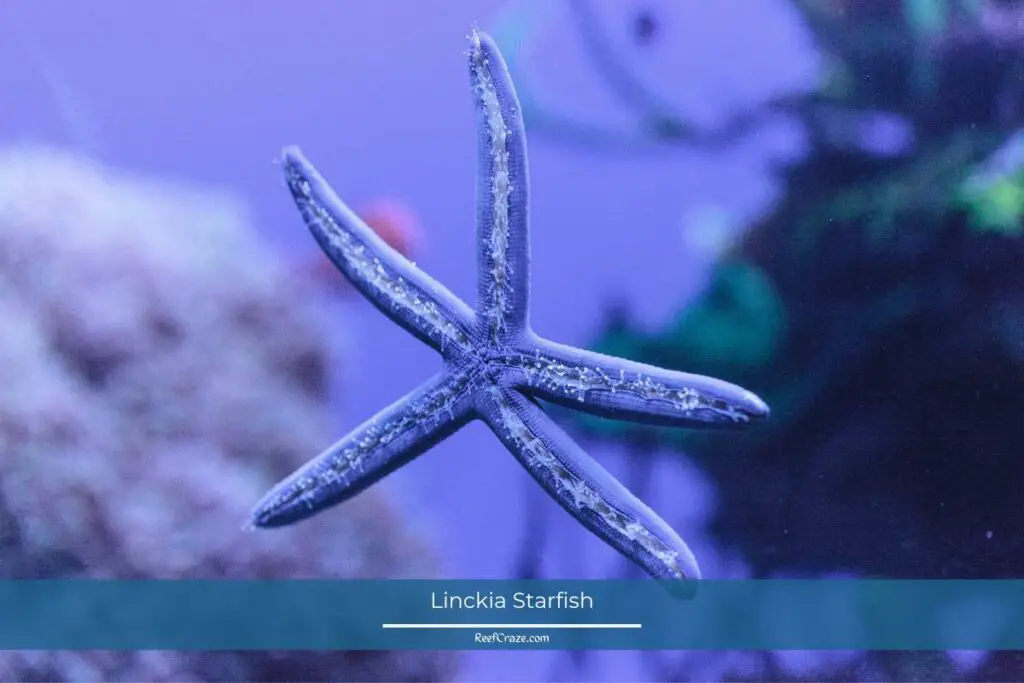
Fun Facts About Starfish (But Important For You!)
- A common issue many hobbyists encounter with their Starfish is their need for careful acclimation and slow changes. They cannot respond well when the water conditions vary swiftly.
- There were repetitions of the fact that some Starfish are risky for fish. But you should also consider the opposite scenario. Some fish cannot resist their long legs. So you should not keep them in the same tank. For example, if you have a predatory fish like the Pufferfish, get a separate tank for your Star.
- Starfish have a fascinating power or ability to regenerate their lost appendages. Sometimes an entirely individual Sea Star can grow out of a lost leg!
Final Words
All the species on my list are the best reef-safe Starfish that have a fair chance of survival in a home tank. For any beginner, a bunch of mini Brittle Starfish would be the best reef-safe Starfish option. They do not grow overly, are hardy enough, and help keep your aquarium waste-free while beautifying it with their cute appearance.
Then you can pick the others after familiarizing yourself with the Brittles. Whichever Star you select will enhance the appeal of your reef tank with its unique personality, shapes, and colors, being a lovely new member for your tank habitat.
